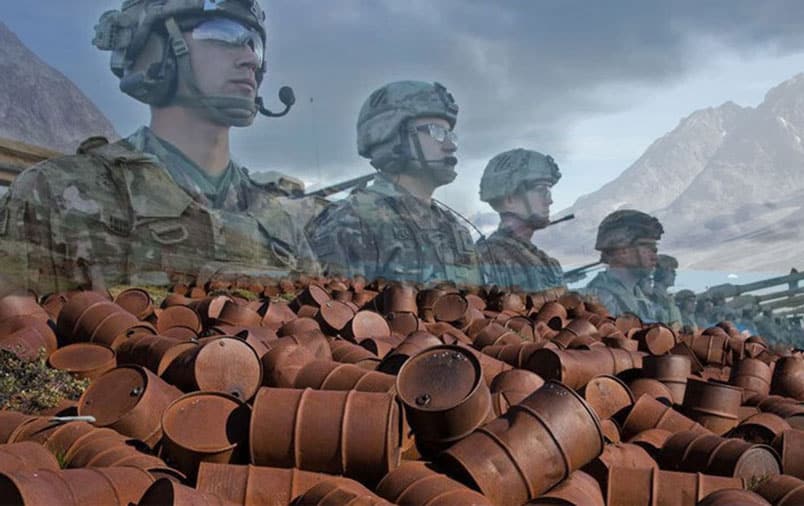According to the Environmental Working Group, there are currently over 700 Department of Defense sites that are heavily contaminated with PFAS, a group of dangerous chemicals, throughout the United States. Many of these sites are military bases where people are stationed for several months to several years, either alone or with their family members, and which may result in toxic exposure to PFAS. The main source of PFAS on these military bases is aqueous film-forming foam, commonly known as AFFF, a fire suppressant whose formula was created by the U.S. Navy together with the well-known company 3M in the early 1960s.
While both parties had been aware of the health dangers of exposure to PFAS ever since the beginning, they continued to manufacture the product, endangering the lives of millions of people. In September of 2020, the Pentagon released important data concerning the number of military sites contaminated with PFAS, which are currently 704, as the Department of Defense had identified 34 new installations where these chemicals were present.
Military firefighters, as well as trainees, use AFFF to extinguish jet fuel and petroleum fires, which unavoidably releases PFAS in the environment at the military bases. Since PFAS are also known as “forever chemicals,” they persist in the environment and are very difficult to completely remove. Therefore, members of the military and their families are exposed to these dangerous chemicals on a regular basis during the period of time they have to spend there, which may result in dire health consequences, including cancer. At the moment, the Environmental Protection Agency is striving to clean up several of these contaminated military bases, which have been deemed Superfund sites.
How to Recognize the Signs of Toxic Exposure
When you are suddenly exposed to a large concentration of PFAS, you may notice immediate symptoms such as headaches, rashes, allergies, nausea, dizziness, neurological problems, difficulty swallowing and breathing, as well as concentration and memory problems. Additionally, you may experience increased cholesterol levels, changes in liver enzymes, and high blood pressure. However, exposure to PFAS on military bases usually occurs over a long period of time, during which these dangerous chemicals gradually accumulate in your body. The main route of exposure to PFAS is inhalation, and these chemicals cannot be eliminated by your body. After a person breathes in PFAS from the atmosphere, these chemicals eventually reach the brain through the bloodstream, which may cause neurotoxicity.
The majority of medical specialists do not have experience with toxicology, which makes diagnosing neurotoxicity a very challenging process. For this reason, you must thoroughly document your toxic exposure and the symptoms you are experiencing and seek multiple opinions from different medical professionals, preferably from some who have expertise in toxicology. The following are the most common symptoms of neurotoxicity, which may seem vague and unconnected at first glance, hence the difficulty of receiving a correct diagnosis upon your first appointment:
- chronic pain
- anxiety
- neurological problems
- confusion
- headaches
- panic attacks
- depression
- cognitive decline
- memory problems
- concentration problems
- multiple sclerosis
- impaired control of the limbs
- headaches or migraines
- sleep disorders
- balance and hearing problems
Furthermore, members of the military with neurotoxicity may also experience multi-organ system malfunction, lower or upper respiratory problems, such as chronic sinus problems, multiple chemical sensitivity, liver or kidney problems and fibromyalgia, or other pain disorders.
If you noticed any of the above symptoms and were stationed at a military base where PFAS were present, you should seek medical attention as soon as possible, as you may suffer from neurotoxicity. Nevertheless, neurotoxicity is unfortunately only one of the numerous diagnoses that a member of the military may receive following toxic exposure. The following are the other health problems that people who were stationed at contaminated military bases and their family members may develop as a result of exposure to PFAS:
- testicular cancer
- kidney cancer
- lung cancer
- brain cancer
- soft tissue cancer
- esophageal cancer
- cervical cancer
- ovarian cancer
- breast cancer
- prostate cancer
- rectal cancer
- bladder cancer
- liver cancer
- leukemia
- multiple myeloma
- non-Hodgkin’s lymphoma
- Hodgkin’s disease
- end-stage renal disease
- Parkinson’s disease
- liver cirrhosis
- scleroderma
- eye defects
- impaired immune system
- generalized hypersensitivity disorder
- miscarriage
- cardiac defects
- choanal atresia
- major malformations
- neural tube defects
- oral cleft defects
- small for gestational age
- fetal death
- low birth weight
Moreover, PFAS has a strong causal relation with thyroid disruption, reproductive and developmental issues, and reduced effectiveness of vaccines. People who were stationed at contaminated military bases, as well as their family members, may be eligible for compensation from the manufacturers of AFFF if they suffer from one of these diagnoses. Similarly, pregnant women who were stationed at military bases where PFAS were lurking and gave birth to children with health problems may also be entitled to financial compensation on behalf of their child. A lawyer who specializes in toxic exposure can help you recover the financial compensation you deserve for your suffering from the liable companies.
On Which Military Bases are PFAS Found?
Over recent years, the issue of PFAS on military bases has become increasingly alarming, as more and more sites have been identified as contaminated with PFAS and other contaminants. Because PFAS are present in high concentrations in AFFF, cancer has become the leading cause of death among both civilian and military firefighters over the past 30 years. Accordingly, firefighters now have a 9% higher risk of developing cancer than the general population, as well as a 14% higher risk of losing their lives to malignant diseases. Some of the most common cancers in firefighters are prostate cancer, bladder cancer, leukemia, testicular cancer, lymphoma, and pancreatic cancer, all of which are being increasingly linked to frequent exposure to PFAS. The following are the most heavily contaminated military bases in the country where thousands of people have been stationed with their families:
- Alameda Naval Base
- Camp Lejeune Marine Corps Base
- Chanute Air Force Base
- China Lake Naval Base
- Dallas Naval Base
- Dover Air Force Base
- Eielson Air Force Base
- Ellsworth Air Force Base
- England Air Force Base
- Jacksonville Naval Base
- Joint Base Langley-Eustis
- Joint Base San Antonio
- Moody Air Force Base
- NAS Oceana Naval Base
- Patrick Air Force Base
- Pease Air Force Base
- Peterson Air Force Base
- Plattsburgh Air Force Base
- Port Hueneme Naval Base
- Richards-Gebaur Air Force Base
- Seymour Johnson Air Force Base
- Wright-Patterson Air Force Base
- Wurtsmith Air Force Base
You should keep in mind that these are only some of the military bases on which PFAS are currently lurking, but there are many more. If you were stationed at one of these military bases, either alone or with your family members, and one of you developed disease from the list above, we strongly encourage you to consult an attorney who can further explore a toxic exposure claim possibly related to PFAS exposure in order to pursue compensation against the AFFF manufacturers. Not only may seeking legal assistance help you financially, but it will also hold the responsible companies liable for their negligence.
As the CFO and Director of Claims at Environmental Litigation Group P.C., Jonathan Sharp is responsible for case evaluation, management of firm assets, and financial analysis. The law firm, which is located in Birmingham, Alabama, has been pursuing compensation on behalf of victims of toxic exposure for the last 30 years and is also dedicated to helping veterans injured by hazardous agents while on active duty.
All content herein is owned by author exclusively. Expressed opinions are NOT necessarily the views of VNR, authors, affiliates, advertisers, sponsors, partners, technicians, or VT Network. Some content may be satirical in nature.
All images within are full responsibility of the author and NOT VNR.
Read Full Policy Notice - Comment Policy































